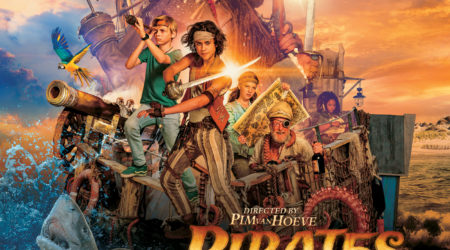 The movie First Man is about the journey of Neil Armstrong from when he was a pilot of an experimental aircraft to the moment where he is the first human being to set foot on the moon. It is a drama with a strong focus on the astronaut’s personal life. The film was directed by Damien Chazelle, whose most recent work before this project was the hit musical La La Land. Apparently, he has a good working relationship with composer Justin Hurwitz, who won the Oscar for his music for the musical, because he was given the assignment to write the music for this movie as well.
The movie First Man is about the journey of Neil Armstrong from when he was a pilot of an experimental aircraft to the moment where he is the first human being to set foot on the moon. It is a drama with a strong focus on the astronaut’s personal life. The film was directed by Damien Chazelle, whose most recent work before this project was the hit musical La La Land. Apparently, he has a good working relationship with composer Justin Hurwitz, who won the Oscar for his music for the musical, because he was given the assignment to write the music for this movie as well.
If you listen to the soundtrack of First Man, three themes surface very clearly. The first theme is a beautiful, short and sad sounding melody, played on the harp and makes it first appearance in the track “Karen.” When I listen to it, I can hear a bit of the La La Land composer in the music: the music reminds me of melodies used in the musical. The theme keeps reappearing throughout the whole album, for example in “It’ll Be An Adventure” where it is played on the theremin. This exotic instrument is important on this album and can be heard quite a few times. At the end of the score, the Karen theme is also played in the track “Crater,” once again on the theremin. While the theme was quite short in all the previous versions, it now is longer, more elaborate and more complete. The best variation of the theme, in my opinion, is “Docking Waltz,” where it is masterfully integrated into a joyful waltz.
The second important theme of the score is the Armstrongs theme, representing Neil Armstrong and his family. It can be heard for the first time in “Armstrong Cabin” and is a wonderful melody played on the harp, consisting of broken chords (the notes of a chord are not played at the same time, but one after the other) creating a playful version of the theme. Just as the Karen theme, it pops up from time to time, for example in “Pat and Janet,” where it is slow and sounds very sad. The theme is also hidden very well in two amazing tracks: “Houston,” where the strings play joyful patterns, and “Apollo 11 Launch,” where the theme is extremely slow and the strings are enhanced to create a very distant and futuristic sound. Later in the track regular sounding violins and percussion join in, up to the point where the brass comes in, to work together with the other musicians towards a massive sounding finale.
The final theme is the astronauts theme, which can first be heard in “Another Egghead.” It is a pattern in the low strings, probably on a double bass, that keeps repeating, together with a pulse, while other instruments play long lines over this pattern. Another good example of this theme can be heard in “Multi-Axis Trainer.” In “Dad’s Fine” the theme sounds a bit darker, and in “End Credits” you can listen to the most comprehensive version of this theme.
The tracks that contain no theme, usually consist of sound design spheres to support a specific scene. Many of these tracks are used in space to express the loneliness or the danger that lurks in the void. There is one song on the album called “Whitey On the Moon,” and another song from the ‘40s that the real Neil Armstrong played in his spacecraft called “Lunar Rhapsody.” . Another track worth mentioning is the bonus track “Sep Ballet, ” containing music from a flute and without any of the themes – at least, as far as I could hear.
Finally, there are two tracks that I want to highlight. The first one is “Quarantine,” where the Armstrong theme and the Karen theme perfectly merge into each other. The Karen theme appears in its expanded version instead of the shorter one which is used more often on the album. The last track I would like the mention is my personal favorite of the album called “The Landing.” When I first saw the scene with this music, I was literally sitting on the edge of my chair, mostly because of the music. The track starts with the Armstrongs theme, played by the violins. This is used as the foundation for the brass to play the Karen theme over it and later in the track, they transition into burst sounds made even more powerful by the accompanying beautiful French horn play. The whole track is a masterful buildup from a delicate start to a massive wall of sound.
This album has all the features to make it a perfect soundtrack in my book. When I am listening to it from start to finish, I relive the whole movie in my mind, using the track names as guidelines. With their help, I can experience a specific scene in my head by listening to the music, where you can see the reason for a certain theme. The music even helps you, to better understand the story on the screen. I really do not want to spoil the movie in this review, but the merging of the two themes is just brilliant and tells you the true purpose of Armstrong’s journey to the moon. I can totally recommend this beautiful score, and I advise you to also watch the movie, and see how well the music fits with the images on the screen.
Listen or buy
- Buy this soundtrack digitally from Amazon.com or iTunes
- Listen to this soundtrack on Spotify
Tracklist
The highlights are in bold.
- X-15 (1:22)
- Good Engineer (1:06)
- Karen (0:45)
- Armstrong Cabin (1:15)
- Another Egghead (1:05)
- It’ll Be an Adventure (0:41)
- Houston (2:16)
- Multi-Axis Trainer (2:54)
- Baby Mark (0:47)
- Lunar Rhapsody (feat. Les Baxter) – Dr. Samuel J. Hoffman (3:04)
- First to Dock (1:27)
- Elliot (0:28)
- Sextant (1:45)
- Squawk Box (1:54)
- Searching For the Agena (1:51)
- Docking Waltz (3:22)
- Spin (1:15)
- Naha Rescue 1 (1:05)
- Pat and Janet (1:34)
- The Armstrongs (2:25)
- I Oughta Be Getting Home / Plugs Out (1:10)
- News Report (0:42)
- Dad’s Fine (1:03)
- Whitey on the Moon – Leon Bridges (1:48)
- Neil Packs (1:25)
- Contingency Statement (1:56)
- Apollo 11 Launch (5:50)
- Translunar (1:01)
- Moon (1:07)
- Tunnel (0:52)
- The Landing (5:31)
- Moon Walk (1:29)
- Home (1:51)
- Crater (2:00)
- Quarantine (2:15)
- End Credits (4:19)
- Sep Ballet (Bonus Track) (1:17)
Total length: 1 hour and 7 minutes
Back Lot Music (2018)




